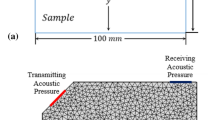Abstract
Ultrasonic Time of Flight Diffraction (TOFD) is now a well established NDE technique finding wide applications in the industry for inspection during manufacture, pre-service and also inservice. While conventionally interpretations of UT images are done by the inspector, a need has always been felt for automated evaluation and interpretation especially when large inspection volumes are involved. Apart from enhancing the speed of inspection, automated evaluation and interpretation provides better reliability of inspection. A number of approaches based on signal analysis coupled with artificial neural networks (ANN) are being tried internationally and limited success has also been obtained. This paper focuses on the development of a semi automatic toolbox for reliable and fast flaw classification in TOFD images using ANN. TOFD images are first acquired and statistical parameters such as mean, standard deviation, energy, skewness and kurtosis are calculated for the region of interest in the images. The classification of the flawed region like Crack, Lack of Fusion, Lack of Penetration, Porosity and Slag Inclusion was materialized using different ANN approaches which made use of these statistical parameters as their input. The process of optimization of a network involves comparison of classification accuracy and the sensitivity of the selected networks. The Cascade Feed Forward Back Propagation (CFBP) network with log sigmoidal activation function proved to be the optimized network model for the data set considered in this study.
Similar content being viewed by others
References
Cenate, T.C.F., Rani, S.B., Venkatraman, B., and Sangeetha, D.N., Classification of defects in time of flight diffraction (TOFD) images using artificial neural network, Proc. 19th Asia-Pac. Conf. Nondestr. Test. (APCNDT), 2013.
Lawson, S.W. and Parker, G.A., Automatic detection of defects in industrial ultrasound images using a neural network, Proc. SPIE, 1996, vol. 2786, pp. 37–47.
Kechida, A., Drai, R., and Guessoum, A., Texture analysis for flaw detection in ultrasonic images, J. Nondestr. Eval., 2012, vol. 31, no. 2, pp. 108–116.
http://www.industrialndt.com/tofd.html.
http://www.mathworks.com.
Veiga, J.L.B.C., de Carvalho, A.A., da Silva, I.C., and Rebello, J.M.A., The use of artificial neural network in the classification of pulse-echo and TOFD ultrasonic signals, J. Braz. Soc. Mech. Sci. Eng., 2005, vol. 27, no.4.
Lahiri, S.K. and Ghanta, K.C., Development of an artificial neural network correlation for prediction of holdup of slurry transport in pipelines, Chem. Eng. Sci., 2008, vol. 63, no. 6, pp. 1497–1509.
Haykin, S., Neural Networks. A Comprehensive Foundation, Englewood Cliffs, NJ: Prentice Hall, 1999.
Seyedtabaii, S., Performance evaluation of neural network based pulse-echo weld defect classifiers, Meas. Sci. Rev., 2012, vol. 12, no. 5, pp. 168–174.
Nandhitha, Manoharan, and Rani, S.B., A comparative study on the performance of the classical wavelet based edge detection for image de-noising in thermographs, Proc. 12th Asia-Pac. Conf. Nondestr. Test. (APCNDT), Auckland, 2006.
Valavanis, I. and Kosmopoulos, D., Multiclass defect detection and classification in weld radiographic images using geometric and texture features, Expert Syst. Appl., 2010 doi 10.1016/j.eswa.2010.04.082
Sahoo, A.K., Yonghong Zhang, and Zuo, M.J., Estimating crack size and location in a steel plate using ultrasonic signals and CFBP neural networks, Proc. Can. Conf. Electr. Comp. Eng. (CCECE), 2008, pp. 1751–1754. doi 10.1109/CCECE.2008.456484410.1109/CCECE.2008.4564844
Badde, D.S., Gupta, A.K., and Patli, V.K., Cascade and feed forward back propagation artificial neural network models for prediction of compressive strength of ready mix concrete, IOSR J. Mech. Civ. Eng., 2012, vol. 3, no. 4, pp. 1–6.
Samanta, S., Mandal, A., and Singh, T.J., Application of ANN in identifying defects in impacted composite, Procedia Mater. Sci., 2014, vol. 6, pp. 926–930. doi 10.1016/j.mspro.2014.07.162
http://en.wikibooks.org/wiki/Artificial_Neural_Networks/Activation_Functions.
Gonzalez, R.C. and Woods, R.E., Digital Image Processing, Upper Saddle River, NJ: Prentice Hall, 2007, 3rd edition.
Subbaratnam, R., Venkatraman, B., and Raj, B., Time of flight diffraction—an alternative to radiography examination of thick walled stainless steel weldments, Proc. 12th Asia-Pac. Conf. Nondestr. Test. (APCNDT), Auckland, 2006.
Author information
Authors and Affiliations
Corresponding author
Additional information
The article is published in the original.
Rights and permissions
About this article
Cite this article
Theresa Cenate, C.F., Sheela Rani, B., Ramadevi, R. et al. Optimization of the Cascade Feed Forward Back Propagation network for defect classification in ultrasonic images. Russ J Nondestruct Test 52, 557–568 (2016). https://doi.org/10.1134/S106183091610003X
Published:
Issue Date:
DOI: https://doi.org/10.1134/S106183091610003X




